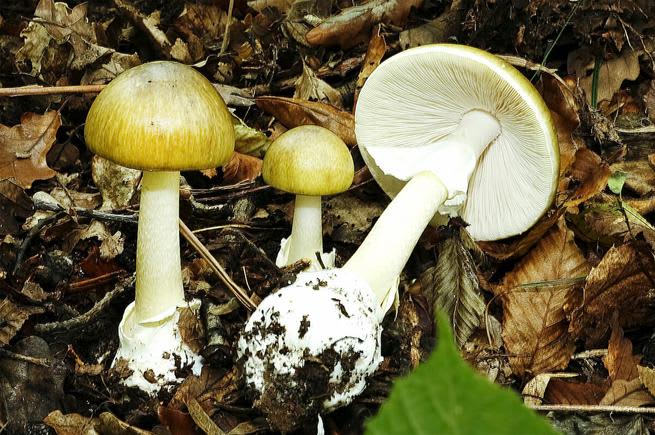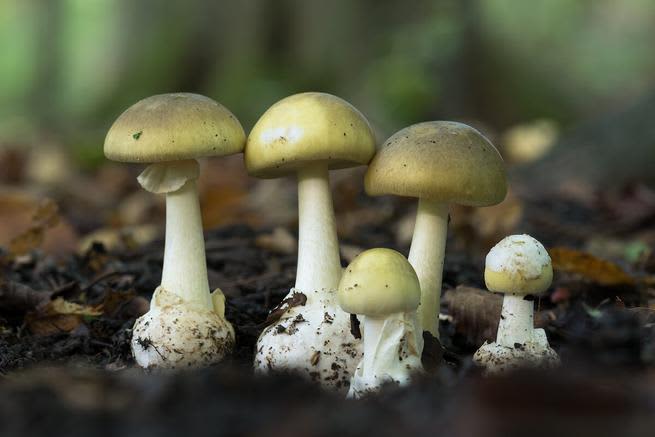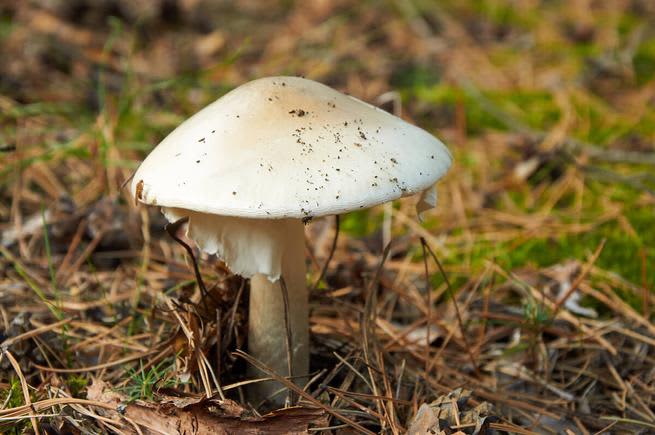

What if we told you that one of the most dangerous, toxic, and deadly mushroom species is also one of the most plain-looking and common? Popularly known as “death caps,” Amanita phalloides mushrooms are, quite possibly, the most dreaded fungi in the world.
Eating just a single cap of these innocent-looking mushrooms can quickly lead to life-threatening organ damage. In fact, these fungi are so sneakily poisonous that they have been used as a murder weapon since the times of Ancient Greece. Here’s what you need to know about these fascinating—and potentially fatal—mushrooms.
What is Amanita phalloides?
Aptly known by the common name “death cap fungus, ”Amanita phalloides (pronounced am-uh-neetah-fal-oydz) is a poisonous mushroom species primarily native to Europe and North America. Due to its resemblance to edible species like the straw mushroom, A. phalloides is often mistakenly consumed by novice mushroom hunters.
The toxins in death cap mushrooms are deadly poisonous, causing almost irreversible liver damage. However, it may also affect other organs such as the kidneys, making the situation even more challenging to manage. The first symptoms appear 6–12 hours after ingestion and might include abdominal pain, vomiting, and diarrhea.
These first signs are followed by more severe side effects such as high fever, jaundice, and seizures. Most of these are the result of liver failure—which is why survivors of death cap mushroom poisoning often require liver transplants. Eventually, the organ damage will lead to coma and death.
While going to the hospital in time will greatly increase the chances of surviving death cap ingestion, the mortality rate is believed to be around 10–30%. Experts estimate that eating just a single cap of A. phalloides is enough to kill an adult human.
Although mushroom poisoning is relatively rare, researchers believe that most can be attributed to death cap mushrooms.
The toxins of Amanita phalloides (amatoxins, virotoxins, and phallotoxins) are not reduced by cooking, freezing, or drying, making it one of the biggest threats for mushroom hunters worldwide (1).
How do death cap mushrooms look?

Death cap mushrooms are very plain-looking, with a 4–16 cm (1.5–6.3 in) convex cap that turns flat as the mushroom ages. The color ranges from dull green to light brown, sometimes showing a few patches of white veil.
The stem measures 5–18 cm (2–7 in), often getting a bit swollen near the base due to the volva, and is white mixed with the cap’s color. It’s usually bald—although certain specimens may show very thin hairs. Near the cap, the stipe sometimes has a white ring that resembles a skirt. The spore print is entirely white (2).
What are the varieties of Amanita phalloides?

Unfortunately, the taxonomy regarding the varieties, strains, and subspecies of Amanita phalloides is somewhat murky.
Mycologists have recorded about 10 possible varieties of death cap mushrooms, although not all experts recognize them as valid. In fact, most of them are thought to be synonyms for the type species—just with slight variations in size and color (3).
The most controversial one is Amanita phalloides var. alba, first described in 1895. The main feature of this variety is that it’s completely white, giving it a rather distinctive albino look. However, some modern mycologists argue that white death cap fungi are so commonly found alongside normal specimens that they can’t be considered a variety (4).
History of Amanita phalloides

The toxicity of Amanita phalloides appears repeatedly throughout history, either as part of folklore legends or non-fictional explanations of mysterious deaths. Experts suggest that ancient Greeks and Romans were already aware of the poisonous nature of the species—meaning that it may have been used as a murder weapon for centuries.
In fact, one of the most important events concerning death caps is the poisoning of the Roman Emperor Claudius in the year 54. Claudius’ last wife was Agrippina the Younger—a powerful woman who, according to historians, did everything to ensure that her only son would inherit the Roman Empire.
Nearly every source points to Agrippina as the author of Claudius’ death. According to these records, Claudius enjoyed some delicious mushrooms at a family dinner before heading to bed. He suddenly fell ill during the following days and finally succumbed to death after vomiting a few times.
Agrippina’s main interest might have been the quick passing of the Roman crown to her son before Claudius’ first son, Britannicus, was of age. As such, most historians agree that she sneaked a few death caps into the Emperor’s meal.
The plan worked flawlessly—and her son Nero (yes, that Nero) inherited the reigns of the Roman Empire (5).
Another key death involving A. phalloides was that of Holy Roman Emperor Charles VI in 1740. According to experts, the emperor ate a dish of mushrooms stewed in oil and had indigestion a few hours later. After about 10 days of worsening illness, he died.
Unlike Claudius’ death, however, there’s no reason to believe that Charles was murdered—instead, he was just a victim of a mistake during mushroom harvesting (6).
As for its taxonomical history, A. phalloides was first described by French botanist Sébastien Vaillant in 1727. Elias Magnus Fries later cataloged the species officially as Agaricus phalloides in 1821. Finally, in 1833, Johann Heinrich Friedrich Link transferred it to the Amanita genus (3).
Health benefits of Amanita phalloides

Due to their poisonous nature, death cap mushrooms are not for consumption. Remember that the toxins in A. phalloides aren’t destroyed by cooking, freezing, or drying!
You should never attempt to use, take, or eat A. phalloides in any way—no matter how safe you think your methods are. Taking just a few grams of death cap fungi can kill you in a matter of days.
However, this doesn’t mean that A. phalloides isn’t useful in a clinical and professional setting.
One of the compounds in A. phalloides (α-amanitin) has been shown to inhibit cancer cell growth and proliferation. As such, the species may help replace specific cancer treatments such as chemotherapy.
More specifically, researchers found that injecting dilutions of A. phalloides directly into the tumors can stop them from growing and spreading. The process causes little to no damage to the surrounding cells, making it a potentially safer approach than chemotherapy.
Cancer treatment with death caps has shown promise in managing mammary duct cancer, leukemia, colon and thyroid carcinoma, and prostate cancer. The therapy may also be accompanied by other treatments, such as antiandrogen drugs or chemical therapy (7).
Of course, it’s essential to remember that this approach is still in early research. You should never use death cap mushrooms in any way unless you’re under the close supervision of a trusted doctor who has informed you of its usage.
Where does Amanita phalloides grow?

Death cap mushrooms are mostly native to Europe and North America. In the United States, the species seems to be more common along the West Coast and in the Mid-Atlantic states of the East Coast. Yet, it’s also possible to find these mushrooms in Australia, Canada (mostly in British Columbia and Victoria), and South America.
The fruiting bodies appear from early summer through late autumn.
Death cap mushrooms are mycorrhizal fungi—meaning they grow in a symbiotic (mutually beneficial) relationship with their host trees. They seem particularly fond of oaks (such as coast live oak) and may appear alone or in groups (2).
The growth conditions, habitat, and appearance of death cap mushrooms resemble that of other less dangerous fungi. As such, experts recommend an abundance of caution whenever you’re harvesting in areas where death caps are common.
What is ethical wildcrafting?
Ethical wildcrafting refers to harvesting natural resources without damaging the surrounding ecosystem. Wildcrafting is often confused with foraging—the key difference is that the former refers to harvesting for medicinal purposes and the latter for eating.
While almost no one harvests death caps on purpose, it’s still important to know these basic guidelines if you’re hunting for similar-looking species (such as paddy straw mushrooms):
- Do some research before heading out—take note of any possible differences between your desired species and death caps.
- Carry a field guide—these handy manuals will help you distinguish death caps from any other species on the spot.
- Don’t overharvest—take only what you need, and don’t share patch locations with other people.
- Pick the mushrooms gently—try to use only your hands, saving scissors and knives for when necessary.
- Ask for permission from the landowner if you’re wildcrafting on private land.
- Check local harvesting laws if you’re wildcrafting on public land.
If you’re new to mushroom hunting, we recommend joining harvesting groups in your area. Veteran fungi lovers will usually be happy to show you how to distinguish toxic species from edible mushrooms.
Is it safe to wildcraft for death cap mushrooms?
No, you should never attempt to wildcraft death cap mushrooms. Keeping this kind of mushroom in your house can be dangerous for kids, pets, and people unaware of their poisonous nature.
Furthermore, avoid harvesting wild mushroom species similar to A. phalloides. Death cap mushrooms can deceive even the most experienced mushroom lover, so it’s best to stay away from them as much as possible.
How do you take Amanita phalloides?

The short answer: You don’t! You should never take death cap mushrooms in any way. The toxins present in the species are extremely poisonous, able to kill you in a matter of days. Even if you were to survive the ingestion, the damage received by your organs would be (at least partially) irreversible.
Moreover, the toxicity of A. phalloides isn’t removed or even reduced by cooking, freezing, or drying the specimens. If you believe you ate death cap mushrooms by accident, go to a hospital as soon as possible.
Medical treatment often consists of gastrointestinal decontamination and using milk thistle as an antidote. Intravenous silibinin (a compound present in milk thistle) protects the liver and prevents further amatoxin poisoning. However, research on this method is still in the early stages.
Amanita phalloides: Nature’s silent killer
Amanita phalloides have earned the nickname “death caps” for a fair reason. The toxins in these fungi are extremely harmful, with experts estimating that the species is responsible for most mushroom-related deaths worldwide. We know they’re beautiful-looking fungi, but it’s best to avoid this one.
If you want to discover other (less dangerous) mushrooms, keep up on shroomer. We cover every kind of fungus—from edible mushrooms to hallucinogenic species—so you’ll surely find a fine alternative to Amanita phalloides.
References
- Juliana Garcia, Vera M. Costa, Alexandra Carvalho, Paula Baptista, Paula Guedes de Pinho, Maria de Lourdes Bastos, Félix Carvalho. “Amanita phalloides poisoning: Mechanisms of toxicity and treatment.” Food and Chemical Toxicology 86 (2015): 41–55. https://doi.org/10.1016/j.fct.2015.09.008
- Michael Kuo. “Amanita phalloides.” MushroomExpert.com (2013). https://www.mushroomexpert.com/amanita_phalloides.html
- Mycobank. “Amanita phalloides.” (Last accessed October 6, 2023). https://www.mycobank.org/page/Name%20details%20page/1139
- First Nature. “Amanita phalloides (Vaill. ex Fr.) Link - Deathcap.” (Last accessed October 6, 2023). https://www.first-nature.com/fungi/amanita-phalloides.php
- Veronika Grimm-Samuel. “On the Mushroom That Deified the Emperor Claudius.” Classical Quarterly 41 (1991): 178–182. https://doi.org/10.1017/S0009838800003657
- R. Gordon Wasson. “The Death of Claudius or Mushrooms for Murderers.” Botanical Museum Leaflets 23(3) (1972). https://www.jstor.org/stable/41762274
- Noor T. Hamdan. “Defining a Role of Amanita phalloides Toxins in Cancer: Research and Therapy.” Journal of Life and Bio Sciences Research 2(1) (2021). https://doi.org/10.38094/jlbsr20137


